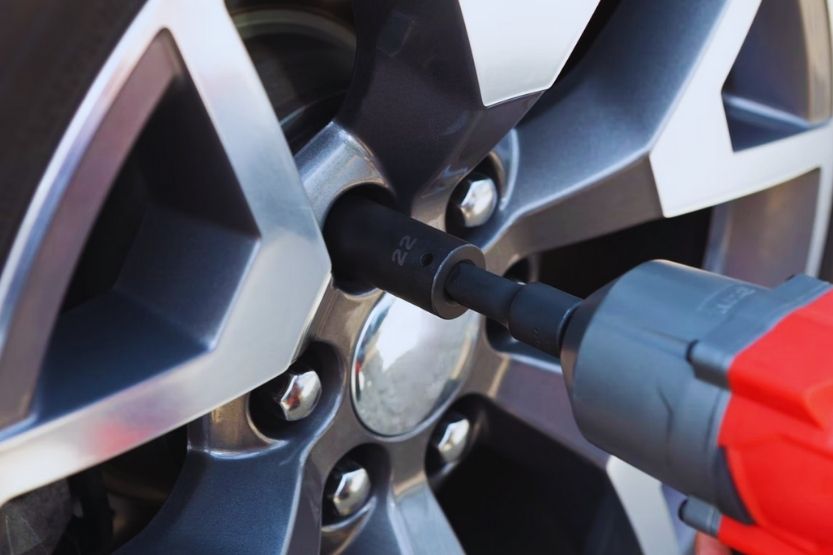Knowing how to change a tire is an advantage when you have a vehicle. If you’re in a rush, it’s good to know if doing the task will take you long or not. So, how long does it take to change a tire?
Generally speaking, it takes 15 minutes to change a tire, but it depends on the situation. A professional can change a tire for 5 to 15 minutes, while an auto care center can take 45 minutes to 5 hours. Help coming from roadside assistance can take less than an hour while doing it on your own can take 15 to 30 minutes.
Read on to learn more about changing a tire and how long it takes.
How Long Does It Take to Change a Tire?

Varies Depending on the Situation
It takes 15 minutes to change a tire, but it varies depending on the situation. A professional can finish changing a tire in 5 to 15 minutes, while an auto care center can take 45 minutes to five hours.
Help coming from roadside assistance can take less than 60 minutes while doing it on your own can take 15 to 30 minutes.
Factors That Affect the Duration of Changing Tire
Several factors affect the duration of changing a tire. For instance, if you can bring your car to an auto care center even with a flat tire, you might still have to wait. They are already attending to other customers who came ahead of you more often than that.
Also, some car care centers follow a process as part of their operating procedure. You might still be asked to fill up a form or wait for your queue to pay. This is why the whole process may even take you 5 hours.
Around 9% of Vehicular Accidents Are Tire-related
According to the U.S. National Highway Traffic Safety Administration (NHTSA) report, roughly 9% of vehicular accidents are tire-related.
Change the Tire When Tread Depth Is Too Low
You don’t have to wait for a flat tire before changing your car’s tires. Once you notice that the tire tread depth is way too low, you must already change your tire.
Replace Tires Every Six Years
Typically, you should replace tires every six years. But then, it also all depends on several factors, such as your driving habits, the frequency of using your car, or how often you drive on rough roads.
In essence, changing a tire should not take long. You can do it if you have the right tools and skills. If you have done it many times before, it should not take more than 15 minutes to change a tire.
How Long Does It Take to Change a Flat Tire
Bring the Car to an Auto Care Center
When you have a flat tire, the first thing that comes to mind is to bring the car to an auto care center. You are guaranteed that all your tire-related concerns will be addressed. But sometimes, you need to wait for your turn for hours, which is quite inconvenient if you are in a hurry.
Save Money and Time By Changing Your Tires
The time to change a flat tire is about 15 to 30 minutes. It is great to change a tire on your own because it can save you time and money. Also, knowing how to do it yourself guarantees that you know how to handle the situation anywhere, you may be.
How to Change Tires

Here’s a guide on how to change tires:
- Find a Safe Location
- Turn On Your Hazard Lights
- Apply the Parking Brake
- Place Wheel Wedges Accordingly
- Remove the Hubcap or Wheel Cover
- Loosen the Lug Nuts
- Position the Jack Under the Car
- Raise the Car Using the Jack
- Unscrew the Lug Nuts
- Remove the Flat Tire
- Mount the Spare Tire
- Tighten the Lug Nuts
- Lower the Car
- Fully Lower the Vehicle
- Put Back the Hubcap
- Stow All Tools and Equipment
- Check the Spare Tire’s Pressure
- Bring Your Flat Tire to a Technician
Let’s briefly talk about each step:
1. Find a Safe Location
Reduce the Speed While Moving to the Safe Side
You will surely notice if you have a flat tire while driving. Do not abruptly pull over or step on the brakes when you see them. Instead, reduce your speed while cautiously moving to the safe side until you find the safest place to park.
Ensure You Parked in an Area with Level Ground
Ensure that you park in an area where there is level ground. That way, you will prevent your car from rolling. Choose an area with a straight stretch of road. Do not park on a curve, as oncoming cars might not be able to notify you right away.
Choose a Wide Shoulder
Also, choose a wide shoulder. Like when you park on a curve, a narrow shoulder is not safe. Running flat might indeed damage your rims. But it is nonetheless better than getting hit by a neglectful driver.
2. Turn On Your Hazard Lights
As soon as you notice that you have a flat tire, immediately turn on your hazard lights and reduce your speed. This will alert other drivers that something’s wrong and you need to pull over.
3. Apply the Parking Brake
Once parked, apply your car’s parking brake to prevent your car from rolling as you prepare to replace the flat tire.
4. Place Wheel Wedges Accordingly
Place the Wheel Wedges in Front of the Front Tires
While the parking brake prevents your car from rolling, it is always best to take extra precautions. Use wheel wedges, which you can place in front or behind the tires, to ensure that your car will not roll as you fix the flat tire.
Placement
If you have a flat rear tire, the wheel wedges must be placed in front of the front tires. In the case of a flat front tire, the wheel wedges must be placed behind the rear tires.
Use Large Stones or Bricks
If you don’t have wheel wedges, you can use large stones or bricks. However, they have to be large enough to prevent the car from rolling.
5. Remove the Hubcap or Wheel Cover
The next step is to remove the hubcap or the wheel cover. Do this before lifting the car with the jack. It is more convenient to remove them while the car is on level ground. If the hubcap does not cover your lug nuts, you can skip this process and move to step 6.
Use the Lug Wrench’s Flat End
You may remove the hubcap using the flat end of your lug wrench. This typically works for most cars. However, some hubcaps require special tools to accomplish the task. So, you should check your manual to determine the proper way of removing your car’s hubcap or wheel cover.
6. Loosen the Lug Nuts
Loosen the lug nuts in a counterclockwise movement using the lug wrench. Continuously do this until you break their resistance. Expect lug nuts to be tightly in place, which means it is not easy to loosen them. It is common to use your foot or all your body weight to untighten them.
Once you break the resistance, loosen the lug nuts for about ½ of a turn. Don’t fully remove them yet.
7. Position the Jack Under the Car
The jack is placed beneath the vehicle frame near the flat tire. Check your car’s vehicle frame too. It will most likely have an area cleared explicitly for the jack. It is best to check your owner’s manual for instructions.
8. Raise the Car Using the Jack
Place a piece of wood beneath the jack before you start raising the car. This is to avoid the jack from settling under the car’s weight, resulting in getting off balance. It is an ideal strategy if the road is made of asphalt.
Once you have perfectly positioned the jack, you can start raising the car. Continue raising it until the flat tire is about 6 inches above the ground. In any case, you must avoid going under the car.
9. Unscrew the Lug Nuts
Once your car is raised correctly, start completely removing the lug nuts. It should be easy for you to remove them all by hand by this time.
10. Remove the Flat Tire
Now, start removing the flat tire. Grip it by the treads. Then, gently and cautiously pull it toward you until it is fully removed from the hub behind it. Set it aside in such a way that it will not roll away.
11. Mount the Spare Tire
Align the rim with the hub bolts to position the spare tire on the hub. Carefully push the tire until the lug bolts appear through the rim.
How Do You Properly Mount a Tire?
12. Tighten the Lug Nuts
Once the lug bolts appear, and the tire is in place, you can put back the lug nuts. Tighten them using your hands.
13. Lower the Car
The next step is to lower your car using the jack. While you can lower it so that it is resting on the ground, don’t wholly lower it just yet. The weight should not yet be placed entirely on the tire. You have to tighten the lug nuts first using the wrench.
Remember that when you loosened them, you turned the wrench counterclockwise. So, to tighten them, you have to turn the wrench clockwise. Again, use your foot and all your weight to make sure you tighten them completely.
14. Fully Lower the Vehicle
By this time, you should have already fully tightened the lug nuts. You can finally bring the car down using the jack. Once done, carefully remove the jack. Then, for the last time, tighten the lug nuts again using the wrench to ensure that the tire is 100 percent secured.
15. Put Back the Hubcap
You can now place the hubcap back. There are, however, hubcaps that don’t fit the spare tire. If this is the case, you don’t have to put back the hubcap anymore. Just keep it for future use.
16. Stow All Tools and Equipment
Now that you are done changing the tire, you are set to stow all the tools and equipment. Make sure that you put everything back in the car before you start to drive.
17. Check the Spare Tire’s Pressure
Check the tire pressure of your spare too. In most cases, a temporary spare needs 60 psi or 420 kPa. If it needs pressure, find the nearest service station to address this immediately.
18. Bring Your Flat Tire to a Technician
A temporary spare tire is not made for long-distance driving. You are not advised to drive at high speeds either. So, make sure to drive until you reach a tire technician cautiously. Have a mechanic check the flat tire to see if it can still be repaired or if it already needs replacement.
Again, how long does it take to change a tire? Usually, professionals take around five to 15 minutes to change tires. Meanwhile, if you have your tires changed in an auto care center, it will take around 45 minutes to five hours. Lastly, changing tires with roadside assistance will take less than an hour.
How Long Does It Take to Change a Tire at an Auto Care Center

If there’s an auto care center near you, it is also a convenient way to address the issue. It may take you a while since you might have to wait for your turn and it will cost you some money. But it’ll not be as tiring as doing it all yourself.
How Long Does It Take to Change a Tire at Walmart?
Walmart’s auto care centers are known for having a lot of customers every day. Based on their figures, they attend to roughly 265 million customers every week all across the United States.
So, it depends on how many vehicles come ahead of you. You can spend an hour waiting only. But it is also possible to spend five hours there.
How Long Does It Take to Change a Tire at Costco?
Costco has auto care centers too. Some customers say that the waiting time at Costco is shorter compared to Walmart. If there are only a few customers, it may take you 45 minutes only. Some say they have experienced waiting for two hours only to replace all four tires.
However, Costco auto care centers only accept tire replacement services if you buy tires from them. Also, their tire installation fee is more costly than Walmart’s.
But if Costco is the only auto care center near you, it is the best option for you.
How Long Does It Take to Change a Tire at Firestone?
Firestone has a different approach when it comes to changing tires. They provide a specific time on when the job will get done. If they go beyond the expected time, they will give you a 10% discount on your next visit.
However, due to their increasing number of customers, some say they have experienced waiting for five hours. But if you are one of their first customers, your waiting time may only be 45 minutes.
Frequently Asked Questions – How Long Does a Tire Change Take
Here are some frequently asked questions on how long a tire change takes:
How Long Should It Take to Change 1 Tire?
Non-professionals typically take 15 to 30 minutes to replace a single tire. In a tire repair shop, the time to change a tire depends on their workload. Generally, a professional can change a tire in 10 minutes or less. But with their busy schedule, it can take roughly 2.5 hours to complete the job.
Should I Change All 4 Tires at Once?
It is recommended that you replace all four tires at the same time. Tires spin independently. If the tread depths or styles are different from one another, it can result in different spinning speeds. This can damage the drive train and is quite risky.
Can You Replace One Tire?
You only replace one tire because you encounter a flat or a blowout tire. While it is okay to replace only one tire, you also must consider how much tread remains on the opposite tire on a similar axle.
Suffice to say that if you replace one tire, check the other tires too. There might be a need to replace them too.
Can I Drive on a Flat Tire Slowly?
Once you notice that you are driving with a flat tire, you can still drive it slowly and cautiously as you pull over. According to Car Talk, the flat tire serves as a “cushion” protecting the wheel’s rim. So, if there is a nearby car care center, you can still carefully drive until you reach there.
However, it is also possible that the tire may no longer be repaired. In this case, there’s no other choice but to replace it.
Conclusion – How Long Does It Take to Change a Tire?
It takes about 15 minutes to change a tire, but it varies depending on the situation. A professional can change a tire for 5 to 15 minutes, while an auto care center can take 45 minutes to 5 hours.
Help coming from roadside assistance can take less than 60 minutes while doing it on your own can take 15 to 30 minutes.
You can count on a professional mechanic, a car care center, or roadside assistance to do the job for you. But there are times when you’re left with no other choice but to change the tire independently. So, it pays to know how to do it. Besides, it will also save you time and money.
Read next:
How Much Does Walmart Charge for Tire Installation?







![Read more about the article Is Bumper a Safe App? [Bumper Review]](https://roadsumo.com/wp-content/uploads/2024/02/Is-Bumper-a-safe-app-1-300x200.png)
![Read more about the article How to Drive in Snow Safely [9 Tips]](https://roadsumo.com/wp-content/uploads/2020/10/how-to-drive-in-the-snow--300x200.jpg)
